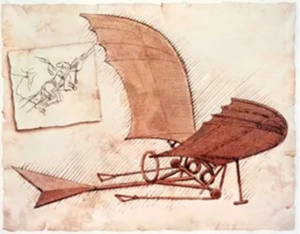Biomimetics, also known as biomimicry, is an interdisciplinary field of science and engineering that draws inspiration from nature to solve technical, design and functional problems. Its name comes from the Greek words bios – life and mimesis – imitation. In practice, this means designing materials, structures, systems or technologies based on mechanisms developed in the natural world.
History and origins
Although the concept of biomimetics as a scientific discipline appeared only in the twentieth century, the very idea of imitating nature has accompanied humanity for centuries. Even the ancients drew inspiration from animals and plants. The mythical wings of Icarus, for example, were inspired by the way birds fly.
One of the earliest documented examples of biomimetic design is Leonardo da Vinci’s flying machine from the late 15th century. The flight mechanism of this machine was based on an analysis of the movement of bird and bat wings. Although its construction never got off the ground, it was an important step towards future attempts to engineer the reconstruction of natural phenomena.

Fig. Ornithopter designed by Leonardo da Vinci
However, the real breakthrough in biomimetic development occurred in the 20th century, alongside progress in molecular biology, materials science, and microscopic technologies. These advances enabled scientists to carefully analyse biological structures, from spider threads to the construction of butterfly wings, and apply their properties to new technological solutions.
Biomimetics in patents
Biomimetics not only drives the development of new technologies, but also increases the potential for commercialising inventions. Nature inspirations lead to more effective, durable and often environmentally friendly solutions, which makes them attractive to both scientists and entrepreneurs. As a result, the number of patents based on biomimetics is growing, and databases containing so-called “biological patents” are becoming a valuable source of inspiration for further innovators.
The process of patenting biomimetic solutions follows the same general rules as other forms of protecting industrial property. The invention must be new, have an inventive step (it cannot be obvious from the state of the art) and be suitable for industrial application. Biomimetic inventions can be reported as either new products or new modes of operation or construction. For example, nature itself (such as the shape of a fish’s fin) cannot be patented, but the method of its technical reproduction and application to a specific device can.
Examples of areas where biomimetic solutions have been used
| Field | Example of a biomimetic invention | Inspired by |
| Aviation | Flexible aircraft wings | Bird and bat wings |
| Automotive industry | Body with air drag reducing surface | Shark skin |
| Medicine | Microscopic painless needles | Female mosquito mouth apparatus |
| Robotics | Robots walking on difficult terrain | Legs of insects and reptiles |
| Construction / Architecture | Ventilation systems in energy-efficient buildings | Termites (termite mounds) |
| Textiles and clothing | Self-cleaning, hydrophobic fabrics | Lotus leaves |
| Power engineering | Serrated Edge Wind Turbine Blades | Humpback whale fins |
| Nanotechnology | Anti-reflective and ultra-thin coatings | Insect eyes (e.g. flies) |
| Electronics | Flexible touch sensors | The skin of a human hand |
| Shipping industry | Anti-fouling coatings on ship hulls | Shark skin |
| Optoelectronics | Color-changing structures without pigments (e.g. in screens, displays) | Butterfly wings and bird feathers |
| Agriculture and agrotechnology | Systems for collecting water from fog in dry climates | Flies living in the Namib Desert |
What was once only an observation of nature is now becoming a full-fledged engineering tool. Both individual inventors and large research companies use biomimetics as a source of breakthrough solutions. This means that patents essentially serve as a form of protection for what has been “read” from nature and then transferred to the world of technology.



